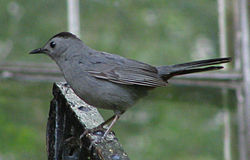- Mimid
-
Mimids 
Gray Catbird
Dumetella carolinensisScientific classification Kingdom: Animalia Phylum: Chordata Class: Aves Order: Passeriformes Suborder: Passeri Infraorder: Muscicapoidea Family: Mimidae
Bonaparte, 1853Genera Allenia
Cinclocerthia
Dumetella
Margarops
Melanoptila
Melanotis
Mimus
Nesomimus
Oreoscoptes
Ramphocinclus
ToxostomaThe mimids are the New World family of passerine birds, Mimidae, that includes thrashers, mockingbirds, tremblers, and the New World catbirds. As their name (Latin for "mimic") suggests, these birds are notable for their vocalization, especially some species' remarkable ability to mimic a wide variety of birds and other sounds heard outdoors.
Description
There are over 30 species of mimids in two larger and some 10 small or monotypic genera. They tend towards dull grays and browns in their appearance, though a few are black or blue-gray, and many have red, yellow, or white irises. They range from 20 to 33 centimetres in length, and 36 to 56 grams in weight.[1] Many mimids have a rather thrush-like pattern: brown above, pale with dark streaks or spots below. They tend to have longer tails than thrushes (or the bigger wrens, which they also resemble) and longer bills that in many species curve downward (Clement & Perrins 2003).
They have long, strong legs (for passerines) with which many species hop through undergrowth searching for arthropods and fruits to eat. Their habitat varies from forest undergrowth to scrub, high-altitude grasslands, and deserts. The two tremblers live in the atypical habitat of rain forests in the Lesser Antilles, and the Brown Trembler has the particularly atypical behavior of foraging while clinging to tree trunks (Clement & Perrins 2003).
All known species build somewhat messy, bulky twig nests in dense growth, in most species on the ground or no more than 2 meters up. They usually lay 2 to 5 eggs that hatch in 12 or 13 days, which is also the length of time the chicks stay in the nest. Breeding usually starts in the spring or early in the rainy season, and many species can have two or even three broods per year. Most failures to fledge young are due to predation. Pairs often stay together for more than one breeding season (Clement & Perrins 2003).
In the history of science
Contrary to often-held belief, the Nesomimus mockingbirds may have played at least as great a role as Darwin's finches in inspiring Darwin's work on his theory of evolution (Curry 2003).
Systematics
Outside the family
Phylogenetic analyses have shown that mimids are most closely related to starlings (Sibley & Monroe 1990, Zuccon et al. 2006). These and oxpeckers (and the Philippine creepers if they are not outright but highly apomorphic starlings) form a group of Muscicapoidea which originated probably in the Early Miocene - very roughly 25-20 mya[2] - somewhere in East Asia (Zuccon et al. 2006). This is evidenced by the Asian-SW Pacific distribution of the most basal starlings (and Philippine creepers) and the North American range of the basal mimids.
They are sometimes united with the starlings in the Sturnidae as a tribe Mimini as proposed by Sibley & Monroe (1990). This makes the expanded Stunidae a rather noninformative group and is probably due to the methodological drawbacks of their DNA-DNA hybridization technique.
Within the family
The mockingbirds with some thrashers seem to form one major clade, while the two other groups and the remaining thrashers seem to form the another, but the basal branching pattern is not well resolved. The tremblers, again, are a monophyletic lineage. The latter, however, are embedded in a paraphyletic catbird-Caribbean thrasher assemblage which consists of many rather basal lineages.(Hunt et al. 2001, Barber et al. 2004)
For detailed information on the evolutionary relationships of the different mimid lineages, see their articles.
- Genus Mimus - typical mockingbirds (some 10 species, includes Mimodes)
- The former genus Nesomimus, now part of Mimus[3] - mockingbirds of the Galápagos Islands (4 species)
- Genus Melanotis - blue mockingbirds (2 species)
- Genus Dumetella - Gray Catbird
- Genus Melanoptila - Black Catbird
- Genus Oreoscoptes - Sage Thrasher
- Genus Toxostoma - typical thrashers (11 species)
- Genus Ramphocinclus - White-breasted Thrasher
- Genus Allenia - Scaly-breasted Thrasher (formerly in Margarops)
- Genus Margarops - Pearly-eyed Thrasher
- Genus Cinclocerthia (2 species)
References
- Barber, Brian R.; Martínez-Gómez, Juan E. & Peterson, A. Townsend (2004): Systematic position of the Socorro mockingbird Mimodes graysoni. J. Avian Biol. 35: 195-198. doi:10.1111/j.0908-8857.2004.03233.x (HTML abstract)
- Clement; Peter; Perrins, Christopher (2003): Mockingbirds. In: Perrins, Christopher (ed.): The Firefly Encyclopedia of Birds: 534–535. Firefly Books. ISBN 1-55297-777-3
- Curry, Robert L. (2003): Darwin and the mockingbirds of Galápagos.
- Hunt, Jeffrey S.; Bermingham, Eldredge; & Ricklefs, Robert E. (2001): Molecular systematics and biogeography of Antillean thrashers, tremblers, and mockingbirds (Aves: Mimidae). Auk 118(1): 35–55. DOI:10.1642/0004-8038(2001)118[0035:MSABOA]2.0.CO;2 HTML fulltext without images
- Sibley, Charles Gald & Monroe, Burt L. Jr. (1990): Distribution and taxonomy of the birds of the world: A Study in Molecular Evolution. Yale University Press, New Haven, CT. ISBN 0-300-04969-2
- Zuccon, Dario; Cibois, Anne; Pasquet, Eric & Ericson, Per G.P. (2006): Nuclear and mitochondrial sequence data reveal the major lineages of starlings, mynas and related taxa. Molecular Phylogenetics and Evolution 41(2): 333-344. doi:10.1016/j.ympev.2006.05.007 (HTML abstract)
Footnotes
- ^ McClure, H. Elliott (1991). Forshaw, Joseph. ed. Encyclopaedia of Animals: Birds. London: Merehurst Press. pp. 183–184. ISBN 1-85391-186-0.
- ^ The seemingly precise dates of Zuccon et al. are not based on material evidence but on a crude estimate; a general Early Miocene age agrees with the phylogeny of other Passeri however.
- ^ American Ornithologists' Union, "Changes since 1 March 2005"
External links
- Mimid videos on the Internet Bird Collection
Categories:- Mimidae
Wikimedia Foundation. 2010.
